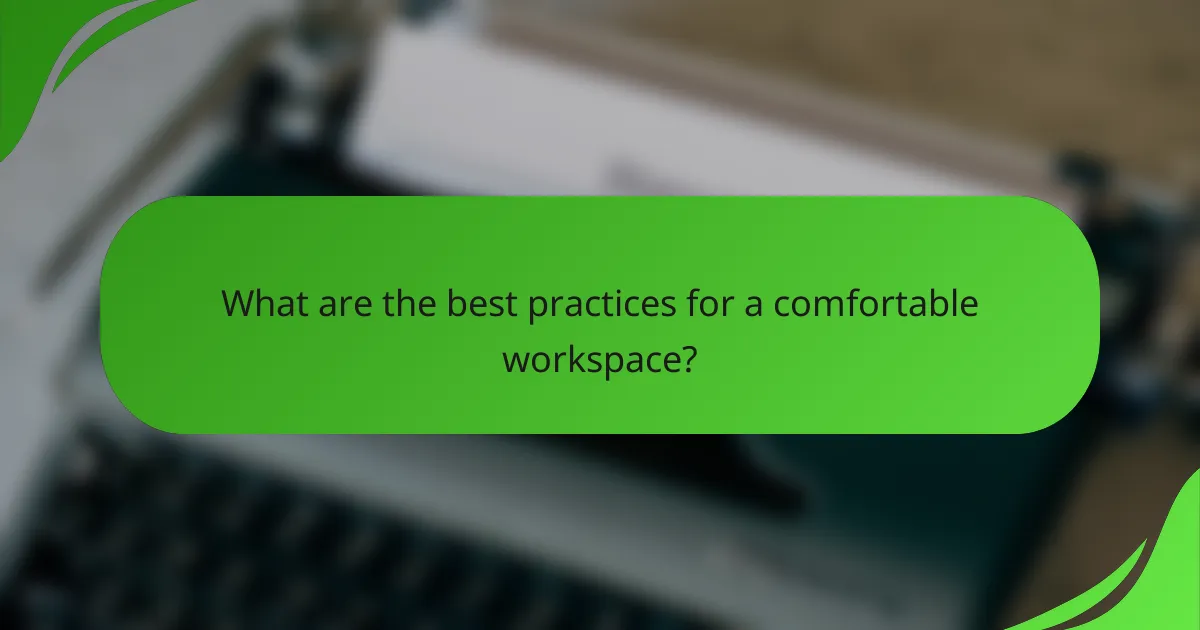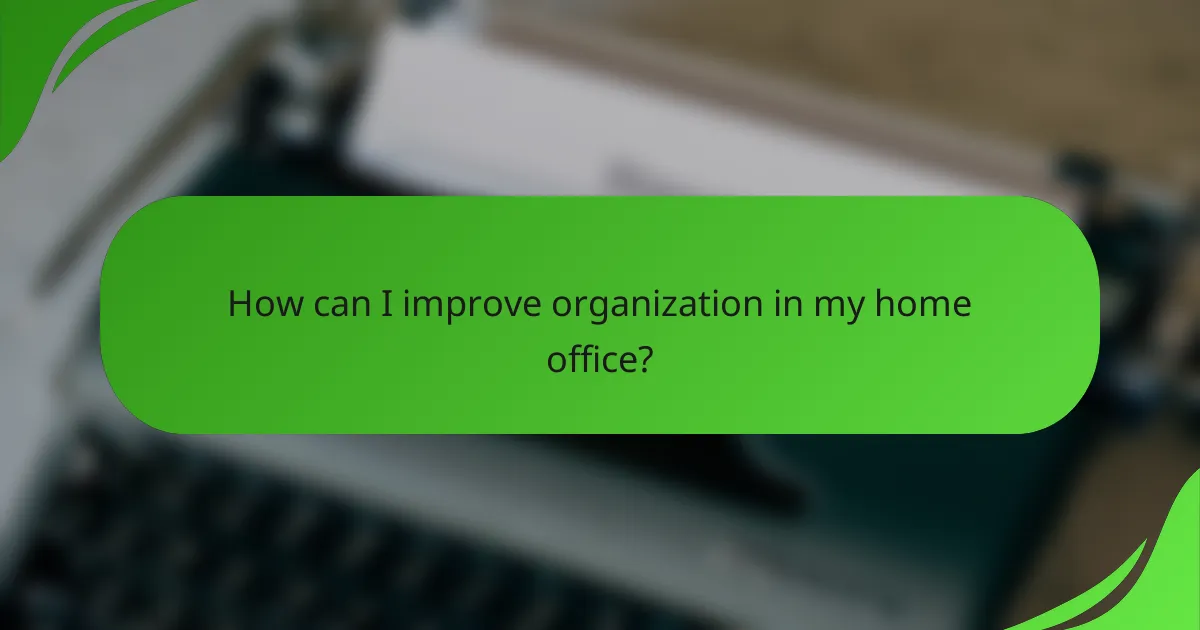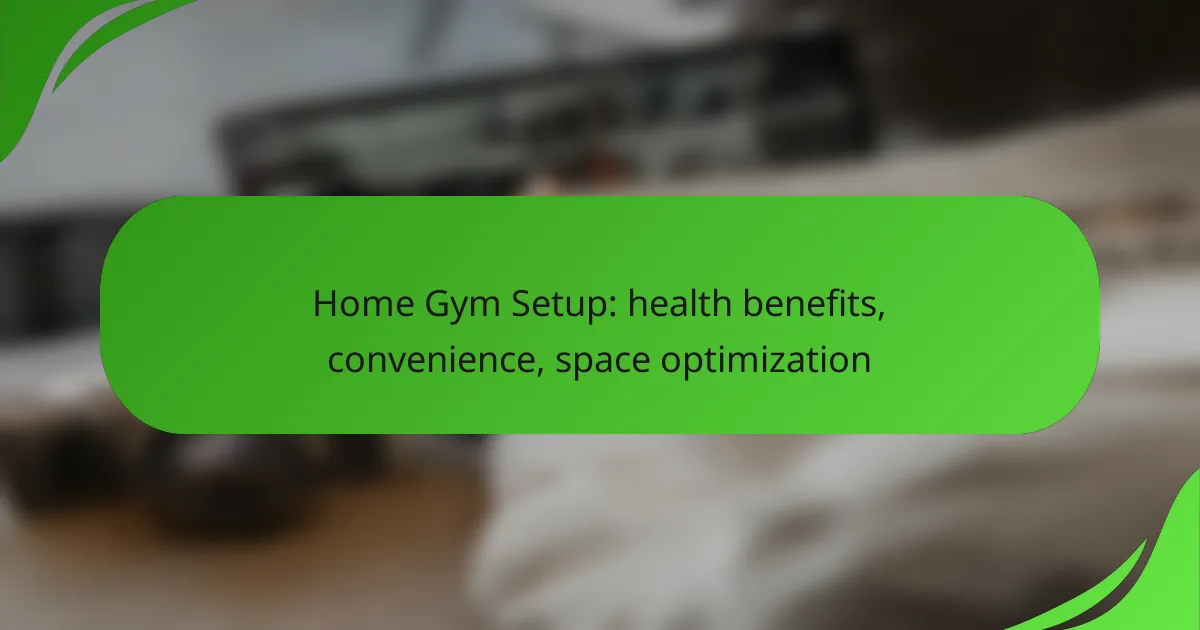Creating an effective home office setup is essential for boosting productivity and ensuring a comfortable work environment. By focusing on ergonomic furniture, effective organization methods, and minimizing distractions, you can enhance your efficiency and overall well-being. A well-structured workspace not only reduces clutter but also supports your work habits, allowing you to thrive in a remote setting.

How can I increase productivity in my home office?
To increase productivity in your home office, focus on creating a comfortable workspace, utilizing effective organization methods, and minimizing distractions. Implementing ergonomic furniture, task management tools, and time blocking techniques can significantly enhance your efficiency and comfort.
Ergonomic furniture
Investing in ergonomic furniture is crucial for maintaining comfort and preventing strain during long work hours. Look for adjustable chairs that support your lower back and desks that allow for both sitting and standing positions. A good rule of thumb is to ensure your monitor is at eye level and your feet are flat on the floor.
Consider adding accessories like a footrest or wrist support to further enhance your setup. These small adjustments can lead to significant improvements in comfort and productivity over time.
Task management tools
Utilizing task management tools can help you stay organized and focused on your priorities. Applications like Trello, Asana, or Todoist allow you to create to-do lists, set deadlines, and track progress. Choose a tool that fits your workflow and integrates well with other applications you use.
Regularly review and update your tasks to maintain clarity on what needs to be accomplished. This practice can prevent overwhelm and keep your productivity on track.
Time blocking techniques
Time blocking involves scheduling specific blocks of time for different tasks throughout your day. This method helps you allocate focused periods for work without distractions. For example, you might block off 9 AM to 11 AM for deep work and 1 PM to 2 PM for meetings.
To implement this technique, use a calendar app to visually organize your day. Be sure to include breaks to recharge, as working in long stretches without rest can lead to burnout.
Minimizing distractions
Minimizing distractions is essential for maintaining productivity in a home office. Identify common distractions, such as noise, social media, or household chores, and take steps to reduce them. For instance, use noise-canceling headphones or set specific times for checking social media.
Creating a dedicated workspace can also help signal to yourself that it’s time to focus. Keep your desk tidy and free of non-work-related items to maintain a clear mind.
Setting clear goals
Setting clear goals provides direction and motivation for your work. Break larger projects into smaller, manageable tasks with specific deadlines. This approach helps you track progress and celebrate small wins along the way.
Consider using the SMART criteria—Specific, Measurable, Achievable, Relevant, Time-bound—to formulate your goals. Regularly revisit and adjust your goals as needed to stay aligned with your overall objectives.

What are the best practices for a comfortable workspace?
Creating a comfortable workspace involves optimizing your desk setup, selecting the right chair, ensuring adequate lighting, and maintaining a suitable temperature. These elements contribute significantly to productivity and overall well-being while working from home.
Optimal desk height
The optimal desk height is crucial for maintaining good posture and comfort during long hours of work. A standard desk height typically ranges from 28 to 30 inches (71 to 76 cm), but this can vary based on individual height and preferences.
To find your ideal desk height, sit in your office chair with your feet flat on the floor and your knees at a 90-degree angle. Your elbows should also be at a 90-degree angle when resting on the desk. Consider using an adjustable desk if multiple users will be sharing the space.
Quality office chair
A quality office chair is essential for comfort and support. Look for a chair that offers adjustable height, lumbar support, and a seat cushion that promotes good posture. Ergonomic chairs are designed to reduce strain on your back and neck.
Investing in a good chair can prevent discomfort and long-term health issues. Aim for a chair that allows you to sit with your feet flat on the ground and your knees slightly lower than your hips. Many chairs also come with features like armrests and reclining options for added comfort.
Proper lighting solutions
Proper lighting is vital to reduce eye strain and enhance focus. Natural light is ideal, so position your desk near a window if possible. If natural light is limited, consider using a combination of ambient and task lighting.
Use adjustable desk lamps with LED bulbs to provide focused light on your workspace. Aim for a brightness level of around 300 to 500 lux for optimal visibility. Avoid harsh overhead lighting that can create glare on screens.
Temperature control
Maintaining a comfortable temperature in your workspace can significantly impact your productivity. The ideal room temperature for working is generally between 20 to 22 degrees Celsius (68 to 72 degrees Fahrenheit).
Use fans or heaters to adjust the temperature as needed, and consider using a programmable thermostat to maintain a consistent environment. Dress in layers to adapt to temperature changes throughout the day, and ensure proper ventilation to keep the air fresh.

How can I improve organization in my home office?
Improving organization in your home office involves creating a structured environment that enhances productivity and reduces clutter. By implementing effective storage solutions, utilizing digital organization tools, and adopting decluttering strategies, you can create a workspace that supports your work habits.
Storage solutions
Effective storage solutions are essential for maintaining an organized home office. Consider using shelving units, filing cabinets, and storage boxes to keep physical documents and supplies neatly arranged. Vertical storage options can save space and make items easily accessible.
Incorporate drawer organizers to separate small items like pens, paper clips, and sticky notes. This not only keeps your workspace tidy but also ensures that you can find what you need quickly, minimizing distractions during work hours.
Digital organization tools
Digital organization tools can greatly enhance your efficiency by streamlining your workflow. Use cloud storage services like Google Drive or Dropbox to keep files accessible from any device while ensuring they are backed up securely. This reduces the risk of losing important documents.
Task management applications such as Trello or Asana can help you prioritize and track your projects. These tools allow you to set deadlines, assign tasks, and monitor progress, making it easier to stay organized and focused on your goals.
Decluttering strategies
Decluttering is a crucial step in maintaining an organized home office. Start by assessing your workspace and removing items that you no longer use or need. Aim to keep only essential items on your desk to create a clean and inviting environment.
Implement a regular decluttering schedule, such as weekly or monthly reviews, to ensure that your workspace remains organized over time. Consider the “one in, one out” rule: for every new item you bring into your office, remove an old one to prevent accumulation.

What are the essential tools for a home office?
Essential tools for a home office include a reliable computer, necessary peripherals, software for productivity, and effective communication platforms. These tools enhance efficiency, comfort, and organization, making remote work more manageable and productive.
Computer and peripherals
A good computer is the backbone of any home office setup. Consider a desktop or laptop with sufficient processing power, ideally with at least 8GB of RAM and a solid-state drive for faster performance. Pair your computer with essential peripherals like a high-resolution monitor, ergonomic keyboard, and mouse to improve comfort and efficiency.
Investing in a good quality webcam and microphone can also enhance video conferencing experiences. These peripherals can significantly improve communication quality during virtual meetings, making interactions more professional.
Office software
Office software is crucial for document creation, data management, and presentations. Popular options include Microsoft Office and Google Workspace, which offer tools for word processing, spreadsheets, and presentations. Choose software that fits your specific needs and allows for easy collaboration with colleagues.
Consider cloud-based solutions for easy access to your files from anywhere. This flexibility is especially beneficial for remote work, ensuring you can work efficiently whether at home or on the go.
Communication platforms
Effective communication platforms are vital for remote collaboration. Tools like Slack, Microsoft Teams, and Zoom facilitate real-time messaging and video conferencing, helping to maintain team cohesion. Select a platform that integrates well with your existing tools to streamline your workflow.
Ensure that your chosen communication tools support file sharing and have features like screen sharing for presentations. This functionality can enhance collaboration and make meetings more productive.
Productivity apps
Productivity apps can help you stay organized and focused while working from home. Tools like Trello, Asana, or Todoist allow you to manage tasks and projects efficiently. These apps often include features for setting deadlines, assigning tasks, and tracking progress.
Consider using time management apps like Pomodoro timers or focus apps to minimize distractions and enhance concentration. Establishing a routine with these tools can significantly boost your productivity throughout the workday.

What should I consider when designing my home office?
When designing your home office, prioritize comfort, organization, and productivity. A well-thought-out workspace can significantly enhance your efficiency and overall work experience.
Layout and flow
The layout of your home office should promote a smooth workflow. Consider placing your desk near natural light sources to reduce eye strain and enhance mood. Ensure that frequently used items are within arm’s reach to minimize distractions and interruptions.
Think about the flow of movement in your space. Leave enough room for easy navigation, and avoid clutter that can impede your focus. A clean, organized layout can lead to better concentration and productivity.
Color psychology
Colors can greatly influence your mood and productivity in a home office. For instance, blue tones are known to promote calmness and focus, while yellow can stimulate creativity. Choose a color palette that aligns with your work style and the tasks you perform.
Consider using accent colors to energize your space without overwhelming it. Soft neutrals combined with vibrant accents can create a balanced environment that fosters both relaxation and motivation.
Personalization
Personalizing your home office can enhance your comfort and connection to the space. Incorporate items that inspire you, such as artwork, plants, or photographs. These personal touches can make the environment feel more inviting and tailored to your preferences.
However, be mindful of clutter. While personalization is important, too many items can lead to distraction. Aim for a balance that reflects your personality while maintaining an organized workspace.








